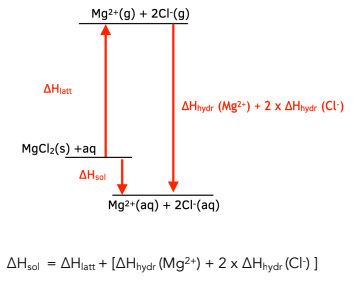Thermodynamic - Calculating Enthalpy Changes of Solution (A-Level Chemistry)
Calculating Enthalpy Changes of Solution
Calculating Enthalpy of Solution
We can use a Born-Haber cycle to calculate the enthalpy of solution using an indirect route.
This involves breaking an ionic lattice to give gaseous ions (enthalpy of lattice dissociation) and then dissolving these gaseous ions in water (enthalpy of hydration).

The equation used to calculate enthalpy of solution from a Born-Haber cycle is:

Using the principle of Hess’s Law, we are able to work out the value of the enthalpy of solution for sodium chloride in this example.
ΔHz = ΔHx + ΔHy
= (+787) + (-346 + – (406) )= +17 kJ mol-1
Worked example: Calculate the enthalpy of solution of magnesium chloride given the following information

Answer:

= 2526 + (-1891+(2 x -381)) = -127 kJ mol-1
As the enthalpy change is exothermic, it shows that magnesium chloride is soluble.
Thermodynamics in A-Level Chemistry is the study of the relationships between heat, energy, and work in chemical reactions and processes. It deals with the transfer of energy and how this affects the state of a system.
Enthalpy is a measure of the total energy in a system, including both the internal energy and the energy associated with the pressure and volume of the system. In A-Level Chemistry, enthalpy changes are used to determine the amount of heat absorbed or released in a chemical reaction.
It is important to calculate enthalpy changes of solution in A-Level Chemistry because this information is crucial for understanding the energy changes that occur during a chemical reaction. Enthalpy changes can help to determine the feasibility of a reaction, as well as the amount of heat absorbed or released during the reaction.
The equation for calculating the enthalpy change of solution is:
ΔH = qp + mL
where ΔH is the enthalpy change, qp is the heat absorbed or released at constant pressure, and mL is the heat absorbed or released due to the change in volume (related to the work done by the system).
The enthalpy change of solution is related to the concentration of the solution because the amount of heat absorbed or released during the reaction is dependent on the number of particles present in the solution. The concentration of the solution affects the number of particles and, therefore, the enthalpy change of the reaction.
The enthalpy change of solution can be used to determine the feasibility of a reaction by comparing the energy required for the reaction to occur with the energy available in the system. If the energy required is greater than the energy available, the reaction is not feasible. If the energy required is less than or equal to the energy available, the reaction is feasible.
The enthalpy change of solution is related to the temperature of the solution because the heat absorbed or released during the reaction is dependent on the temperature of the solution. As the temperature of the solution changes, the enthalpy change also changes. This relationship between enthalpy change and temperature is used to calculate the enthalpy change of solution in A-Level Chemistry.





Still got a question? Leave a comment
Leave a comment